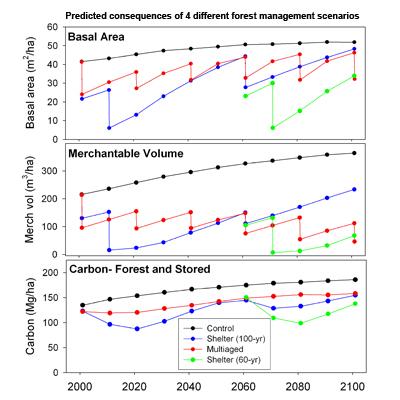Linking Forest Structure to Viable Development Pathways of Diversely Managed Northern Conifers: A Pilot Study Exploring the Potential of FIA Data for Modeling Regional Carbon Dynamics

Partial-cutting, where a portion of standing timber is left to grow following a commercial timber harvest, has become common practice on timberlands in Maine. As a result, forest structure is becoming increasingly complex over time as more multi-aged stands are created. The conifer dominated forests of northern New England are well-suited to multi-aged management, yet forest managers and scientists lack accumulated experience with this approach.
To address this need, NSRC researchers superimposed USDA FIA (Forest Inventory and Analysis) style inventory plots on an existing long-term sampling grid at the Penobscot Experimental Forest in Maine. They used re-measurement data from the Forest to assess the ability of a density management diagram (DMD) and a growth and yield model called Forest Vegetation Simulator (FVS) to predict development of stands managed using multi-aged approaches. The carbon consequences associated with four different forest management scenarios were compared using FVS, taking into account the fate of forest products resulting from harvests.
Researchers found that individual FIA-style plots did not capture the degree of structural complexity present in the managed multi-aged stands. Neither the DMD nor FVS modeling frameworks provided reliable predictions of stand dynamics, particularly for long-term forecasts (50-100 years). However, by calibrating FVS and making adjustments to the regeneration module, they obtained more reasonable outputs, at least over modest lengths of time (10-20 years). Consistent with findings from other studies, forest management appears incapable of sequestering additional carbon compared to a no-management scenario, barring natural catastrophic losses.
Download printable version [PDF]
Download full final report [PDF]
